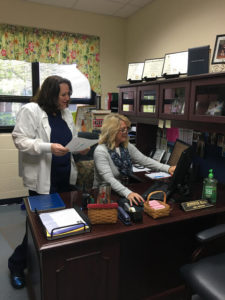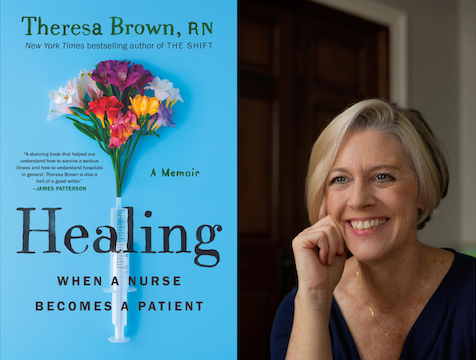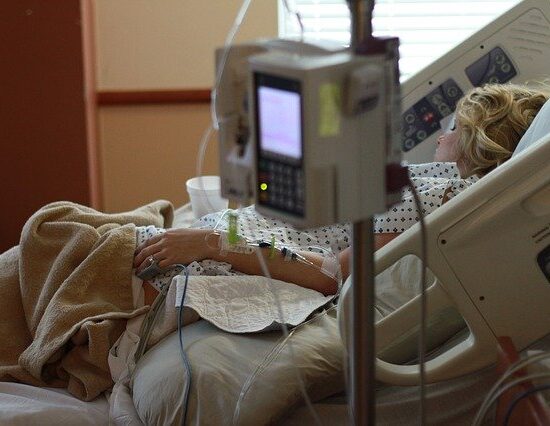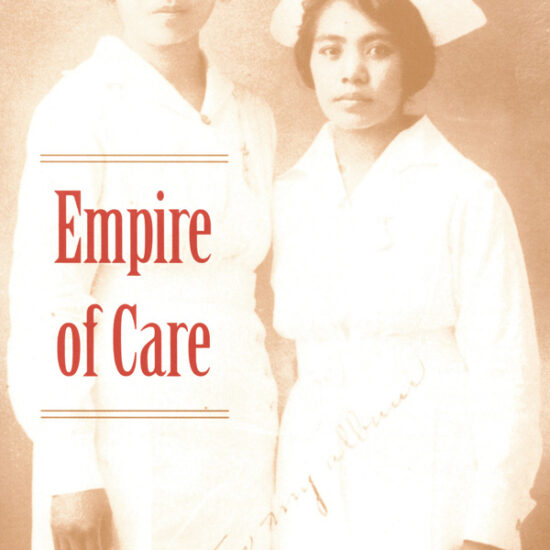– Advocates say move would improve learning outcomes
Putting a full-time nurse in every Kentucky school would not only provide health care, but improve education outcomes, say advocates of the idea.
“We need a nurse in every school because we need to quit thinking about health and education as separate entities, because they are not,” said Eva Stone, an advanced-practice registered nurse and co-chair of the school-nurse initiative being mounted by nurses’ groups and their allies.
One of their strongest allies is retired educator Terry Brooks, executive director of Kentucky Youth Advocates, says he is “absolutely convinced that the non-cognitive issues that kids face, like health, have as much to do with their capacity to learn as a teaching method.”
Brooks added, “There is only so much blood that you can wring out of a turnip when it comes to teaching methods. You always want great teaching methods, but my goodness, we have been working on that for decades with results that are a whole lot more the same than they are different. So if it is not producing significant change, we’ve got to look for something else. . . . You are not hearing me say that this is a silver bullet, that, boy, a school nurse is going to fix everything, but I think the presence of a school nurse not only impacts kids’ health, but it impacts the kids’ capacity to learn.”
Those assertions are supported by research, including a recent study that looked at the association between school nurses and academic outcomes of high-school students. It showed that when there was a nurse in a public high school on a full time, every-day basis, graduation rates were higher, absentee rates were lower and ACT scores were higher,” Teena Darnell, assistant professor of nursing at Bellarmine University, said about her research.
“And traveling nurses showed no significance on any level. So if you had a part-time nurse, there was no significant difference on academic performance,” said Kathy Hager, a Bellarmine nursing professor and president of the Kentucky Nurses Association.
Hager is also a member of the “Every School Needs a Nurse, Every Day” initiative that is advocating mandates for a full-time nurse in every public school, as recommended by the American Academy of Pediatrics.
The National Association of School Nurses supports a ratio of one nurse for every 750 healthy students. This was the recommendation of the pediatrics academy until just last year, when it changed its recommendation to a nurse in every school, saying that “The use of a ratio for workload determination in school nursing is inadequate to fill the increasingly complex health needs of students.”
Kentucky has one nurse for every 1,254 students, according to a 2011 KYA report, the latest data available. The Kentucky Department of Education only records nurses hired by school boards (187 this year) and does not include any hired by different funding streams.
Darnell’s research found that 42 percent of Kentucky’s high schools had a full-time nurse, 37 percent had a part-time nurse and 20 percent of them didn’t have one at all. Among all schools, 44 percent had full-time registered nurses; 48 percent had either RNs or licensed practical nurses.
State law requires schools to “make any necessary arrangement” to provide for the immediate health needs of students. Stone said they “do that for the most part, but . . . there is no system of monitoring in place.”
When a nurse isn’t available, student health services are often provided by school employees who are trained to provide those services. Many students have conditions that need frequent attention.
Out of 655,475 students enrolled in Kentucky’s public schools last year, 20,711 were diagnosed with attention deficit hyperactive disorder, 14,054 with allergies, 55,897 with asthma, 1,142 with Type 1 diabetes and 5,259 with a seizure disorder, according to the KDE.
Vicki Williams, school-health coordinator and one of three school nurses in Calloway County, which has about 3,400 students, said the school system has about 150 employees who have completed medication training, and others who know certain medical procedures, like blood-sugar testing, taking blood pressure and using g-tubes to the stomach.
And though she is allowed to delegate administration of insulin to other employees, Williams said she isn’t comfortable doing that. “That is where I will draw the line,” she said. “I will not train anybody to give insulin except myself and any other licensed nurse in my building.”
She said schools have many distractions and “Too much insulin is life threatening, and I don’t feel comfortable putting that on somebody who has not had more training than a quick diabetes training after school one day.”
Hager didn’t question that unlicensed employees can be trained to provide such services, but said what they don’t have are the assessment skills of a school nurse. “It takes years of experience to recognize what a person looks like with a low blood sugar reaction,” which often occurs with young diabetics, she said.
Nurses could be front-line fighters of big-ticket health items, they say
Stone, who worked as a school nurse for 16 years, passionately argues that school nurses could and should be part of a long-term plan to improve Kentucky’s dismal health outcomes by improving the health of its children. But she said she also knows the best way to get educators to pay for a full-time school nurse is to “speak the language of education.”
“We can talk about health care if we want, and all of the health care people will agree with what we need to do, but the educators don’t have buy in in Kentucky and that is because they don’t see the value,” with some exceptions, she said.
“I want to be clear in saying that I’m not a proponent of just sticking a body in the building. I want a nurse in every school, and I’m going to fight for that, but I think we have to be intentional about what we are asking for and what we are doing,” Stone said.
For example, she said she would like to see a comprehensive school health system in Kentucky that allows school nurses to be care coordinators for all students’ health needs, which would put them “on the front line of every health problem that is a big ticket item for Kentucky.”
“We could have a very different outcome for children in our state,” she said. Later saying, “But of course that means you have to look at school nurses differently than just putting band-aids on boo boos and checking kids for head lice.”
Kentucky ranks in the bottom 10 states in the nation for multiple health indicators in children, such as poor physical and mental health, diabetes, asthma, obesity, poor oral health and substance abuse.
Donna Mazyck, executive director of the National Association of School Nurses, also linked school nurses to education, saying they “provide a critical link between students, health and learning.” She said the latest federal education law clearly recognizes the intersection between health and education.
“In the law there is a phrase called ‘well rounded education,’ — and what does that mean? That means health education, physical education, as well as all the other core courses,” she said. “We believe that students need access to a school nurse every day.”
Stone also mentioned the importance of the law, noting that one of its goals is to tackle chronic absenteeism, which school nurses can improve. “If they aren’t in school, then they don’t learn,” she said, adding that students who are chronically absent are often the ones in the achievement gaps.
Nurses can boost attendance, which boosts school revenue
Kentucky’s school districts want to keep students in school partly because attendance is part of the formula that determines how much money schools get.

Jenny Sexton, RN, works on attendance with Jennifer Allen, an assistant principal at Madison Southern High School
Jennifer “Jenny” Sexton, the school nurse at Madison Southern High School, went from being a part-time nurse at the high school to full-time this year. She and others are actively working to improve attendance through diligent monitoring and positive outreach to chronically absent students and their parents.
Early results have already shown improvements. Madison Southern improved attendance to 94.32 percent in December 2016 from 93.65 percent last year, which means that 41 more students have been attending school this year, on average. Sexton said the improvements will be greater in the next analysis, because she said daily attendance has been running around 95 or 96 percent.
Michelle Malicote, Sexton’s school-health-clinic services manager, said, “We are actually seeing that Ms. Jenny, so-called, generated roughly $7,000 in one month, because she kept so many students sitting in their seats for so many more days.”
There are several funding models for school nurses. Most of those Stone mentioned involve some funding from Medicaid, or funding somehow connected to Medicaid. For example, several school districts have contracted with health clinics to provide school nurses and in-school access to clinical care that can be billed to the students’ health insurance, which is often Medicaid.
Asked if this initiative needs to be put aside until the Trump administration repeals and replaces Obamacare, she said, “Well, we really ought to wait and see,” but said another solution would be for Kentucky to lead a demonstration project “to show what we could do with an intentional school health program — and then you couldn’t argue with the outcomes.”
Brooks said, “We are going to have to wait and see, to some degree, how health care shakes down at the federal level. I think federal decisions will have a real impact on whether a door is opened for Kentucky to pursue school-based health, and if that door opens, I hope we walk right through it.”
However, Brooks said he is hearing support from lawmakers and school officials for the idea of putting a nurse in every school, and is optimistic about the likely changes to Medicaid that will give states more autonomy.
“I actually am more optimistic about this as an idea whose time has come than I’ve ever been,” Brooks said. “I believe that the concept has been accepted and I think that the flexibility that we may be getting from the feds would actually enhance rather than be a detriment to this.”
Mazyck said community involvement is often needed to secure funding for school nurses. “Creative solutions require communities to rise up and say, ‘This is what we need,’ and that they value it,” she said. “I don’t hear people saying they don’t want them. I hear them saying, ‘How can we afford them? How can this be sustainable?'”
Brooks said, “I don’t think this is some abstract, theoretical, pie-in-the-sky idea. I think if we as a commonwealth said we are really going to go about the business of making a commitment to school based health, I think there are ways we could figure out flexible, creative, win-win ways to fund that proposition. I cannot imagine a single principal in Kentucky not welcoming a school nurse if funding was available.”
This article was produced as part of the Center for Health, Media & Policy’s Health Care Workforce Media Fellowship supported by a grant from the Johnson & Johnson Foundation. It was originally published by Kentucky Health News, an independent news service of the Institute for Rural Journalism and Community Issues, based in the School of Journalism and Media at the University of Kentucky, with support from the Foundation for a Healthy Kentucky.










